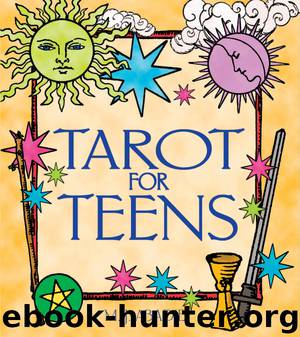Tarot for Teens by M. J. Abadie

Author:M. J. Abadie
Language: eng
Format: epub
Publisher: Inner Traditions / Bear & Company
Published: 2012-02-10T16:00:00+00:00
Evidence suggests that the Minor Arcana were linked up with the Major Arcana sometime in the fourteenth or fifteenth centuries, and that they originally were used both as playing cards and for fortune-telling. There are no standardized symbolic meanings for the Minor Arcana, as there are for the Major Arcana. Therefore, interpretations vary. Some who write about the Tarot concentrate on the Major Arcana and virtually ignore the Minor Arcana, while others use a primarily numerological approach, since most of the cards are number cards.
STRUCTURE OF THE MINOR ARCANA
The Minor Arcana are set up like a deck of ordinary playing cards, with four suits, in this case, Wands, Pentacles, Swords, and Cups. Each suit has fourteen cards: ten number cards and four court cards (King, Queen, Knight, and Page). We’ll take an introductory look at all these components now, so you can begin to see how the numbers, court cards, and suits fall into useful categories. Then, in the following chapters, we’ll examine each component from every which way until you’ve got a working knowledge of every card in the deck.
Let’s begin with the number cards. The ten number cards of each suit, starting with Ace and going up to Ten, are called the pip cards. Pips are the dots or markings on each number card that denote that card’s numerical value. The pip cards have no spiritual or teaching qualities, and in some decks are not illustrated at all, the pips being merely decorative. Pip cards generally refer to the ordinary, routine events and emotions of daily life. Occasionally, they will describe personal characteristics either of the reader or someone involved in the situation. As a rule of thumb, pip cards are about situations or emotions currently happening or about to happen.
Although pip cards are illustrated in many different ways, the illustrations have no specific relationship to the number, which is the important quality of the pips. In many decks, pip cards carry no pictures at all but are merely stylized in accordance with their suit symbol. For example, the Four of Wands may be just four Wands arranged attractively on the card.
A major exception is the Waite deck, in which each pip card depicts a person or people performing a definite activity. Unfortunately, these illustrations can cause confusion in interpretation. Sometimes the illustration contradicts the overall meaning of the suit involved and makes no specific reference to the numerological meaning.
It has been speculated that the pip cards were given illustrations as a memory tool, especially in the case of the Waite deck, upon which many other modern decks have been based. True enough, the Waite deck’s illustrations stick in the mind. For example, the vivid illustration of nine Swords lined up over the head of a young woman sitting up in bed holding her head in her hands as if just awakened from a horrible nightmare is unforgettable.
Download
This site does not store any files on its server. We only index and link to content provided by other sites. Please contact the content providers to delete copyright contents if any and email us, we'll remove relevant links or contents immediately.
Becoming Supernatural by Dr. Joe Dispenza(7105)
Tools of Titans by Timothy Ferriss(6946)
The Witchcraft of Salem Village by Shirley Jackson(6584)
Inner Engineering: A Yogi's Guide to Joy by Sadhguru(5895)
The Four Agreements by Don Miguel Ruiz(5510)
The Power of Now: A Guide to Spiritual Enlightenment by Eckhart Tolle(4755)
The Wisdom of Sundays by Oprah Winfrey(4626)
Room 212 by Kate Stewart(4107)
Fear by Osho(4085)
Pale Blue Dot by Carl Sagan(4001)
The David Icke Guide to the Global Conspiracy (and how to end it) by David Icke(3881)
Rising Strong by Brene Brown(3780)
Animal Frequency by Melissa Alvarez(3755)
How to Change Your Mind by Michael Pollan(3676)
Sigil Witchery by Laura Tempest Zakroff(3651)
Real Magic by Dean Radin PhD(3568)
Secrets of Antigravity Propulsion: Tesla, UFOs, and Classified Aerospace Technology by Ph.D. Paul A. Laviolette(3445)
The Art of Happiness by The Dalai Lama(3382)
Man and His Symbols by Carl Gustav Jung(3315)
